Fitting Experimental Data to Straight Lines - Chemical Engineering
Fitting Experimental Data to Straight Lines - Chemical Engineering
Fitting Experimental Data to Straight Lines - Chemical Engineering
Create successful ePaper yourself
Turn your PDF publications into a flip-book with our unique Google optimized e-Paper software.
1<br />
prepared by Annette D. Shine, August 2006<br />
<strong>Fitting</strong> <strong>Experimental</strong> <strong>Data</strong> <strong>to</strong> <strong>Straight</strong> <strong>Lines</strong><br />
(Including Error Analysis)<br />
The purpose of this document is <strong>to</strong> assist students with<br />
statistical analysis of experimental data by listing some equations<br />
for straight line data fitting and error analysis. Personally, I find<br />
statistics texts very hard <strong>to</strong> plow through, so I am writing this<br />
document in understandable English for an engineer who wants <strong>to</strong><br />
use statistics without being dazzled by the brilliance of the subject.<br />
If you find any mistakes, or want <strong>to</strong> suggest something else that<br />
needs <strong>to</strong> be included, or know of a book that is comprehensible and<br />
thus supercedes this treatment, please contact me.<br />
Linear Least Squares <strong>Fitting</strong> of a <strong>Straight</strong> Line with Slope and<br />
Intercept<br />
Any least squares curve- or line-fitting algorithm optimizes the<br />
constants of a fitting equation by minimizing the sum of the squares<br />
of the deviations of the actual (data) values from the values<br />
predicted by the equation. You probably know how <strong>to</strong> do linear<br />
least squares fitting of a straight line already, since most scientific<br />
calcula<strong>to</strong>rs and graphing software packages do this au<strong>to</strong>matically for<br />
you. Nevertheless, I will present it here so that: (1) you will be<br />
aware of assumptions inherent in use of the canned programs, (2)<br />
you can verify with your own calculations that you get the same<br />
answers as the canned programs, and (3) I can build on this base for<br />
cases where some of the "canned" assumptions are not valid.
Given: A set of n experimental data points,<br />
x1, y1<br />
x2, y2<br />
: :<br />
: :<br />
xn, yn<br />
where x is the independent variable (i.e., the thing you fix or<br />
consider fixed, such as time when you are measuring reaction<br />
kinetics, or voltage when you are using a pressure transducer), and<br />
y is the dependent variable (i.e., the thing that you want <strong>to</strong><br />
determine, such as extent of reaction or pressure). The xi values are<br />
assumed <strong>to</strong> be listed from lowest <strong>to</strong> highest. (It is not really<br />
necessary here <strong>to</strong> list the points in order of increasing xi, but it will<br />
be in a later part of this document.)<br />
Furthermore, let's assume that the relationship between x and<br />
y is a linear one (if it's not, fitting a line <strong>to</strong> the points is worthless).<br />
Let y = ax + b<br />
be the equation of the best fit line <strong>to</strong> the data. We wish <strong>to</strong><br />
determine the values of both the slope a and the intercept b. If we<br />
assume that each data point carries equal weight, i.e., each yi point<br />
has exactly the same actual (not relative) error associated with it,<br />
then we find a and b by minimizing the sum of the squares of the<br />
deviations of the actual values of yi from the line's calculated value<br />
of y. The formulas for a and b are:<br />
∑ xi<br />
yi<br />
) − ( ∑ xi<br />
)( ∑<br />
2<br />
2<br />
( n∑<br />
xi<br />
) − ( ∑ xi<br />
)<br />
( n<br />
yi<br />
)<br />
a = SLOPE =<br />
(1)<br />
∑<br />
2<br />
i<br />
( x )( y ) − ( xi<br />
)( xi<br />
yi<br />
)<br />
b = INTERCEPT =<br />
(2)<br />
2<br />
( n x ) − ( x )<br />
2<br />
∑<br />
∑<br />
i<br />
2<br />
i<br />
∑<br />
∑<br />
In all equations, the summation sign is assumed <strong>to</strong> be from i=1 <strong>to</strong><br />
i=n.<br />
i<br />
∑
For example, consider this actual calibration data for the<br />
vortex flowmeter from the frictional losses experiment in junior lab:<br />
Voltage (xi) Flow rate, liter/s (yi)<br />
1.01 0.00<br />
1.27 0.19<br />
1.85 0.58<br />
2.38 0.96<br />
2.83 1.26<br />
3.13 1.47<br />
3.96 2.07<br />
4.91 2.75<br />
The linear least squares fit <strong>to</strong> this data gives the line:<br />
yi = 0.70303729738 xi -0.7153519908 (liters/sec)<br />
(It is always a good idea <strong>to</strong> carry along as many significant figures as<br />
possible during statistical calculations because truncation errors<br />
may be significant when subtracting two nearly equal values. I've<br />
included all these figures above so you may check the calculation<br />
yourself, if you wish.)<br />
If you use the linear curve-fitting routine in Excel, you get:<br />
yi = 0.703 xi -0.7154 (liters/sec)<br />
with a correlation coefficient R 2 = 0.9999.<br />
Uncertainties (Errors) In Calculated Slope and Intercept<br />
Suppose that the calculated slope and/or intercept from the<br />
"canned" equations above was really the experimental quantity of<br />
interest, say a reaction rate constant or an initial reaction rate. In<br />
this case, you will want <strong>to</strong> determine the error associated with the<br />
slope or intercept so you can present the experimental uncertainty,<br />
i.e., <strong>to</strong> give a plus-or-minus value. The formulas (for points with<br />
equal error, as above) are:<br />
n<br />
ERR − a = SLOPE ⋅ ERROR = S *<br />
(3)<br />
2<br />
( n<br />
x )<br />
3<br />
2<br />
∑xi) − ( ∑<br />
i
where<br />
2<br />
∑ xi<br />
ERR − b = INTERCEPT ⋅ ERROR = S *<br />
(4)<br />
2<br />
( n − x )<br />
( − − )<br />
=<br />
− 2<br />
∑ yi<br />
axi<br />
b<br />
S<br />
n<br />
4<br />
2<br />
∑xi) ( ∑<br />
Note that s is the square root of the quantity found by dividing the<br />
sum of the squares of the deviations from the best fit line, by the<br />
number of data points you have beyond the minimum required (two<br />
points determine a straight line) <strong>to</strong> fit the specified curve. The<br />
quantities a and b are those calculated for the best fit line.<br />
For the above data, s = 0.011769957 liter/sec (Note that s<br />
has the units of y). The associated errors in the slope and intercept<br />
are<br />
slope error = 0.003343664 liter/sec-Volt and<br />
intercept error = 0.009842206 liter/sec.<br />
This means that the relative errors are<br />
relative slope error = 0.003343664/0.70303729738 = 0.48% and<br />
relative intercept error = 0.009842206/0.7153519908 = 1.38%.<br />
Note that the slope has a smaller relative error than the intercept, so<br />
that you can get more reliable estimates if you plot the data in such<br />
a fashion that the quantity you want <strong>to</strong> extract is the slope.<br />
Alternately, be sure you always do error analysis when using a<br />
calculated intercept value, since the error can be large, especially if<br />
the fit is not <strong>to</strong>o good. (The above example has excellent data fit, as<br />
seen by the R 2 value.)<br />
Linear Least Squares <strong>Fitting</strong> and Error of a <strong>Straight</strong> Line Which<br />
MUST Go Through the Origin.<br />
This is the same case treated above, except that now we FORCE<br />
the line <strong>to</strong> go through the point (0, 0). Because we specify that the<br />
intercept is 0, the only parameter we can determine is the slope a,<br />
i.e., we find the best “a” value for the equation<br />
2<br />
i<br />
(5)
y = ax.<br />
For example, in a chemical reaction, we know that the rate of<br />
disappearance of species A must be zero if the concentration of A is<br />
zero. In the past, you may have just used the canned fitting<br />
routines, hoping that the intercept value came out small anyhow;<br />
the following are the correct equations <strong>to</strong> use:<br />
5<br />
∑<br />
∑<br />
xi<br />
yi<br />
a = SLOPE =<br />
(6)<br />
2<br />
x<br />
i<br />
∑<br />
∑<br />
− = ⋅ = 0 , 0<br />
2 *<br />
xi<br />
ERR a SLOPE ERROR S<br />
(7)<br />
x<br />
Here, s0,0 has the same meaning as s in eq (5) above, except that<br />
only one additional point is needed <strong>to</strong> draw a straight line through<br />
the origin, so<br />
S<br />
0,<br />
0<br />
( − )<br />
=<br />
−1<br />
∑ yi<br />
axi<br />
n<br />
Uncertainties Resulting from Interpolation and Extrapolation of<br />
<strong>Straight</strong> Line <strong>Data</strong><br />
2<br />
Since many measurements are now made with electronic<br />
instruments, engineers are frequently required <strong>to</strong> assess the<br />
reliability of an indirectly measured variable that was arrived at<br />
through comparison with an instrument calibration curve.<br />
Alternately, it is sometimes necessary <strong>to</strong> extrapolate experimental<br />
data <strong>to</strong> arrive at a prediction of a variable at some condition beyond<br />
the experimentally measured range. When the experimental or<br />
calibration data can be fit <strong>to</strong> straight lines, the formula for<br />
estimating error at a point is the same whether the point is<br />
interpolated or extrapolated . Specifically,<br />
Given: A set of n experimental data points, rank ordered so that x1<br />
is the lowest xi value, and xn is the highest xi value.<br />
Let y = ax + b<br />
i<br />
2<br />
(8)
e the best fit straight line <strong>to</strong> the data, with a and b calculated as<br />
above. If you wanted <strong>to</strong> predict a value for y, say y*, given a<br />
specific value of x, say x*, you would obviously predict that the most<br />
probable value of y* when x=x* is<br />
y* = ax* + b.<br />
This would be true regardless of whether x* fell within the<br />
experimental range of xi. Now, suppose you want <strong>to</strong> know how<br />
"correct" this y* value is, i.e., you want <strong>to</strong> know how much<br />
uncertainty is associated with the predicted y* value.<br />
For a confidence interval of 100(1-α)% (e.g., at the 95% confidence<br />
level, α=0.05), the ± uncertainty associated with y* is:<br />
2<br />
1 n(<br />
x * −x)<br />
y * _ ERR = tα<br />
/ 2,<br />
n−2<br />
⋅ S ⋅ +<br />
(9)<br />
2<br />
n n x )<br />
2<br />
∑xi−( ∑<br />
Where S is given by eq (5) if the line was NOT forced through the<br />
origin, x is the average x-value of the experimental data points, i.e.,<br />
x =<br />
and<br />
∑<br />
x<br />
n<br />
i<br />
tα/2, n-2 is the critical value for the t distribution, which can be<br />
looked up in statistical tables (e.g., see<br />
http://socr.stat.ucla.edu/Applets.dir/T-table.html). The value of n-<br />
2 is called the number of degrees of freedom (since these are the<br />
“extra” points beyond what was needed <strong>to</strong> determine the original<br />
straight line), and is often given the symbol ν or df in statistical<br />
tables. Be careful in using t-distribution tables that you use the<br />
correct numerical value for α/2 (i.e., HALF the difference from 100%<br />
of the confidence interval).<br />
If the line fit <strong>to</strong> the original data was forced through the origin, then<br />
the number of degrees of freedom is only n-1, and S is calculated<br />
from eq (8).<br />
6<br />
i
Consider again the voltage/flow rate vortex flowmeter<br />
calibration data given above. Suppose now that in the labora<strong>to</strong>ry,<br />
you measured three different flow rates with the vortex flowmeter,<br />
such that the voltage readings were:<br />
1.50 V, 3.45 V and 4.61 V. What would be the expected flow rate,<br />
<strong>to</strong>gether with its +/- error term for each voltage?<br />
Suppose we want a 95% confidence interval; then α = 0.05. From<br />
the calibration data above, n = 8, Σxi = 21.34, Σxi 2 = 69.3154,<br />
Σ(yi-axi-b) 2 = 0.000831191, S = 0.011769957 liter/sec (Note that S<br />
has the units of y), and t0.025, 6 = 2.447, so the three predicted<br />
values of flow rates, <strong>to</strong>gether with their estimated uncertainties due<br />
<strong>to</strong> the calibration curve fitting are:<br />
x* (V) y* (liter/s) +/- y* (liter/s) Relative<br />
error in y (%)<br />
1.50 0.3391 0.013962 3.7 %<br />
3.45 1.710138 0.012436 0.73 %<br />
4.61 2.5256644 0.018876<br />
0.75 %<br />
You can also use the t-equation above <strong>to</strong> find uncertainties in<br />
extrapolated values of y, provided you know that the linear<br />
relationship holds in the extrapolated regime (e.g., you couldn't<br />
extrapolate friction fac<strong>to</strong>r vs. Reynolds number data taken for<br />
1
Weighted Least Squares <strong>Straight</strong> Line <strong>Fitting</strong><br />
All the above equations assumed that each data point had the<br />
same amount of absolute (not relative) error associated with it. This<br />
is rarely the case in practice. It is much more common for relative<br />
errors <strong>to</strong> be similar, or for errors <strong>to</strong> be larger at the extreme ends of<br />
the measurement range. In any case, it makes sense in curve fitting<br />
<strong>to</strong> give the least amount of weight <strong>to</strong> points that are the least<br />
reliable. This is properly accomplished statistically by weighting<br />
each point by the inverse square of its standard error when<br />
calculating the best-fit slope or intercept.<br />
To use this method, you must first establish the standard error<br />
of each point; this quantity will be called ei. If you made repeat<br />
measurements, you should use the standard deviation. If the points<br />
you are plotting are actually derived quantities (e.g., the slopes of<br />
previously plotted best-fit lines), then you should use error<br />
propagation <strong>to</strong> get ei (e.g., use the slope error above). All previous<br />
equations assumed ei was a fixed constant, so it didn't really matter<br />
whether the (fixed) error resided with xi or with yi; here, the error is<br />
presumed <strong>to</strong> reside with yi. Hence, for curve-fitting purposes, enter<br />
your data points so that yi is the coordinate with the most error.<br />
(This is usually, but not always, the case "naturally," since we tend<br />
<strong>to</strong> use simple things such as time or reciprocal temperature as the<br />
independent x coordinate.) Note that ei is an absolute, not relative,<br />
error, so it has the same units as yi.<br />
For weighted linear regression, the best fit values of the slope<br />
a and the intercept b are then given by:<br />
and<br />
xi<br />
yi<br />
xi<br />
yi<br />
1<br />
( ∑ )( ∑ ) − ( ∑ )( ∑ )<br />
2 2<br />
2<br />
2<br />
ei<br />
ei<br />
ei<br />
ei<br />
a = SLOPE =<br />
(10)<br />
2<br />
xi<br />
2 xi<br />
1<br />
( ∑ ) − ( ∑ )( ∑ )<br />
2<br />
2<br />
2<br />
e e e<br />
i<br />
8<br />
i<br />
i
or alternately<br />
xi<br />
yi<br />
xi<br />
( ∑ ) − a(<br />
2 ∑ ) 2<br />
ei<br />
ei<br />
b = INTERCEPT =<br />
(11)<br />
x<br />
9<br />
∑<br />
e<br />
i<br />
2<br />
i<br />
xi<br />
xi<br />
yi<br />
yi<br />
xi<br />
( ∑ )( ∑ ) − ( ∑ )( ∑ )<br />
2<br />
2<br />
2<br />
2<br />
ei<br />
ei<br />
ei<br />
ei<br />
b = INTERCEPT =<br />
(12)<br />
2<br />
xi<br />
2 xi<br />
1<br />
( ∑ ) − ( ∑ )( ∑ )<br />
2<br />
2<br />
2<br />
e e e<br />
i<br />
The uncertainties in the slope a and intercept b of a least squares<br />
line that was weighted by the individual errors of the points are<br />
given by:<br />
1<br />
∑ 2<br />
ei<br />
aERR = slope _ error _ of _ weighted _ line =<br />
(13)<br />
2<br />
xi<br />
1 xi<br />
2<br />
( ∑ )( ∑ ) − (<br />
2<br />
2 ∑ ) 2<br />
e e e<br />
xi<br />
∑ 2<br />
ei<br />
bERR = int ercept _ error _ of _ weighted _ line =<br />
(14)<br />
2<br />
xi<br />
1 xi<br />
2<br />
( ∑ )( ∑ ) − (<br />
2<br />
2 ∑ ) 2<br />
e e e<br />
If the line MUST pass through the origin, then the slope is<br />
determined from:<br />
.<br />
xi<br />
yi<br />
∑ 2<br />
ei<br />
a = slope _ of _ line _ through _ origin =<br />
(15)<br />
2<br />
xi<br />
∑ 2<br />
e<br />
i<br />
i<br />
i<br />
2<br />
i<br />
i<br />
2<br />
i<br />
i<br />
2<br />
i<br />
i
The error in the slope of a weighted least squares line passing<br />
through the origin is given by:<br />
err _ a = slope _ error _ of _ weighted _ origin _ line =<br />
The parameter S0,0 is defined in Eq. (8).<br />
S0,<br />
0<br />
2<br />
xi<br />
∑ 2<br />
ei<br />
(16)<br />
Note that, since all of the above relationships, including the<br />
error terms, involve only a few different sums, they should be<br />
relatively easy <strong>to</strong> program on a spreadsheet.<br />
10


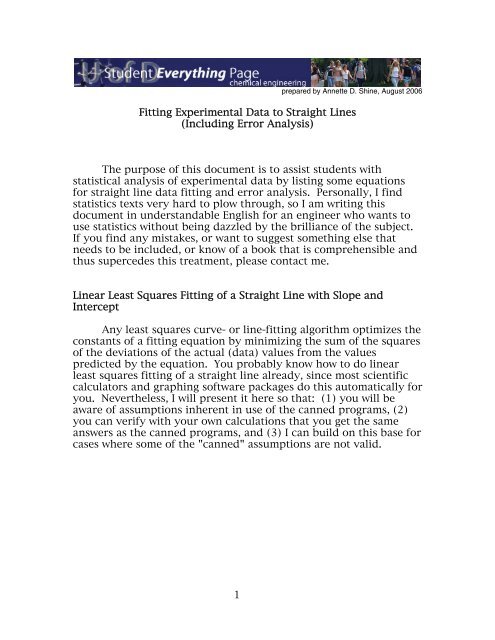

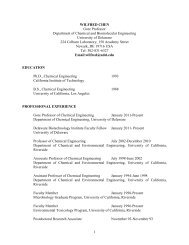
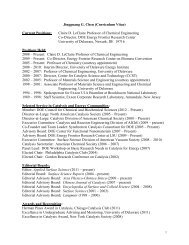
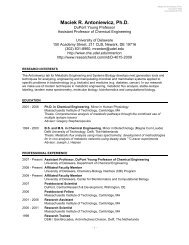
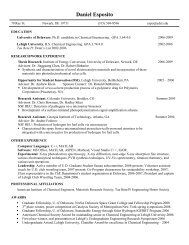

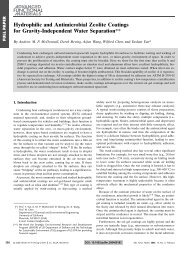
![Parallel labeling experiments with [U-13C] - Chemical Engineering ...](https://img.yumpu.com/6655424/1/190x253/parallel-labeling-experiments-with-u-13c-chemical-engineering-.jpg?quality=85)
